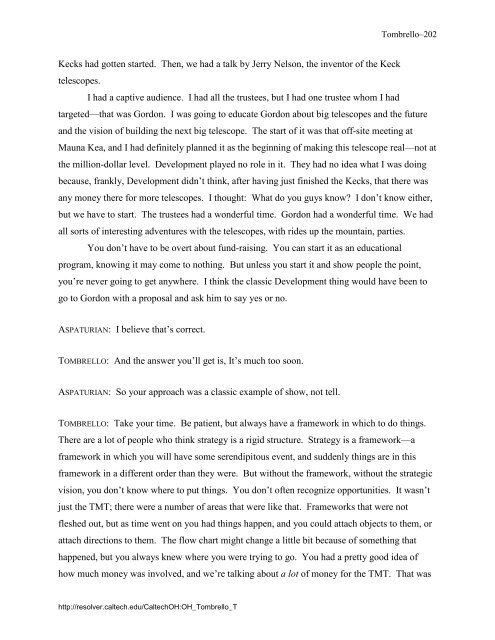Interview with Thomas A. Tombrello - Caltech Oral Histories
Interview with Thomas A. Tombrello - Caltech Oral Histories
Interview with Thomas A. Tombrello - Caltech Oral Histories
You also want an ePaper? Increase the reach of your titles
YUMPU automatically turns print PDFs into web optimized ePapers that Google loves.
<strong>Tombrello</strong>–202<br />
Kecks had gotten started. Then, we had a talk by Jerry Nelson, the inventor of the Keck<br />
telescopes.<br />
I had a captive audience. I had all the trustees, but I had one trustee whom I had<br />
targeted—that was Gordon. I was going to educate Gordon about big telescopes and the future<br />
and the vision of building the next big telescope. The start of it was that off-site meeting at<br />
Mauna Kea, and I had definitely planned it as the beginning of making this telescope real—not at<br />
the million-dollar level. Development played no role in it. They had no idea what I was doing<br />
because, frankly, Development didn’t think, after having just finished the Kecks, that there was<br />
any money there for more telescopes. I thought: What do you guys know? I don’t know either,<br />
but we have to start. The trustees had a wonderful time. Gordon had a wonderful time. We had<br />
all sorts of interesting adventures <strong>with</strong> the telescopes, <strong>with</strong> rides up the mountain, parties.<br />
You don’t have to be overt about fund-raising. You can start it as an educational<br />
program, knowing it may come to nothing. But unless you start it and show people the point,<br />
you’re never going to get anywhere. I think the classic Development thing would have been to<br />
go to Gordon <strong>with</strong> a proposal and ask him to say yes or no.<br />
ASPATURIAN: I believe that’s correct.<br />
TOMBRELLO: And the answer you’ll get is, It’s much too soon.<br />
ASPATURIAN: So your approach was a classic example of show, not tell.<br />
TOMBRELLO: Take your time. Be patient, but always have a framework in which to do things.<br />
There are a lot of people who think strategy is a rigid structure. Strategy is a framework—a<br />
framework in which you will have some serendipitous event, and suddenly things are in this<br />
framework in a different order than they were. But <strong>with</strong>out the framework, <strong>with</strong>out the strategic<br />
vision, you don’t know where to put things. You don’t often recognize opportunities. It wasn’t<br />
just the TMT; there were a number of areas that were like that. Frameworks that were not<br />
fleshed out, but as time went on you had things happen, and you could attach objects to them, or<br />
attach directions to them. The flow chart might change a little bit because of something that<br />
happened, but you always knew where you were trying to go. You had a pretty good idea of<br />
how much money was involved, and we’re talking about a lot of money for the TMT. That was<br />
http://resolver.caltech.edu/<strong>Caltech</strong>OH:OH_<strong>Tombrello</strong>_T

















